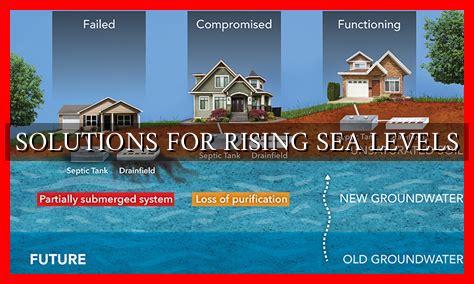As the cascading tides of climate change relentlessly lap at the shores of our coastal cities, the implications of rising sea levels become increasingly palpable. These amphibious specters threaten to swallow islands whole and submerge sprawling urban landscapes, leaving behind a precarious legacy of loss. So, what can we do about this pressing crisis? By adopting innovative strategies and profound shifts in policy and public awareness, we begin to chart a course through these tempestuous waters. This article presents practical solutions for combatting the ominous rise of ocean levels.
Embrace Nature: The Power of Green Infrastructure
Perhaps the most elegant strategy in our arsenal against rising seas is the deployment of green infrastructure. Imagine a sumptuous blanket of vegetation, enveloping our coastal zones and marshlands, acting as a powerful buffer against the relentless onslaught of waves. Wetlands, mangroves, and coral reefs all provide natural barriers, absorbing excess water while simultaneously housing essential biodiversity.
Restoration of these ecosystems is not merely a chore; it is an urgent necessity. Coastal wetlands alone can absorb nearly 50% of incoming floodwaters, mitigating disaster during storm surges. Beyond their protective capabilities, investing in the rejuvenation of these habitats promotes carbon sequestration, thereby combating climate change in two crucial ways—protection and mitigation. Through concerted efforts in community engagement and the utilization of local resources, we can reclaim and fortify these indispensable ecosystems, creating a natural wall against the advancing sea.
Innovate with Coastal Urban Planning
As we gaze towards the horizon, it becomes abundantly clear that traditional urban planning must adapt to the shifting landscape. The rise of innovative architectural concepts—including amphibious housing and floating cities—presents a compelling vision for our urban futures. Picture a city that dances effortlessly atop the waves, where buildings are anchored yet buoyant, capable of adjusting to fluctuating tides.
Incorporating resilient designs into urban infrastructure allows cities to evolve sustainably. Constructing seawalls, tidal barriers, and strategically designed drainage systems can help mitigate flood risks. This forward-thinking architecture is paramount; it symbolizes humanity’s adaptability in the face of adversity. Ultimately, integrating smart urban planning with climate resilience ensures that our coastal communities not only withstand rising sea levels but thrive in spite of them.
Technological Interventions: Harnessing Innovation
In our quest for answers, the fusion of technology and environmental science opens new vistas of potential. Smart technologies such as real-time monitoring systems can provide critical data on shifts in sea levels, enabling communities to prepare proactively rather than reactively. Advanced modeling software can anticipate flooding patterns, informing vital decisions and allowing for granular adjustments in urban layouts.
Moreover, breakthroughs in materials science enable the creation of water-resistant and resilient construction materials, fortifying structures against the corrosive nature of saltwater. Imagine a future where homes are constructed from biodegradable composites infused with protective technologies that fight off the wear of time and tide. This synergy of innovation paves the way for a more harmonious relationship with our oceanic surroundings.
Empowering Communities through Education and Advocacy
Rising sea levels are a collective challenge that calls for a unified response. The power of community engagement stems from grassroots activism and awareness campaigns that inform citizens of the realities of climate change and sea-level rise. Empowering communities through education transforms passive observers into active participants, equipping them with knowledge and resources to make a difference.
Local organizations can host workshops that illustrate the effects of rising sea levels on their specific geographies while discussing adaptive strategies. By fostering a sense of stewardship, we can create an environment where individuals not only understand the threats posed but also feel motivated to engage in meaningful action. From restoring local wetlands to advocating for sustainable policies, every small action contributes to a larger narrative that positions communities as champions of change.
Policy Reformation: Legislative Steps Forward
Behavioral shifts, infrastructural innovations, and community engagement are crucial, yet they must be undergirded by robust policy reform. Effective legislation that addresses climate change and sea-level rise can catalyze transformation across local, state, and national platforms. Crafting laws that incentivize renewable energy use, protect coastal environments, and promote sustainable development is imperative.
Building a coalition of policymakers, scientists, and advocates can facilitate a culture of collaboration where knowledge flows freely, navigating through the labyrinth of bureaucracy. It is vital that these policies not only seek to mitigate but also prioritize adaptation strategies that are equitable and inclusive, recognizing that vulnerable populations bear the brunt of environmental changes. Legislative frameworks must be forged through inclusive dialogue that respects indigenous knowledge while integrating scientific research.
In conclusion, confronting the challenge of rising sea levels demands a multifaceted approach that intertwines ecological restoration, innovative planning, technological advancements, community empowerment, and systemic policy reform. Each of these spheres provides unique solutions, and the symbiosis among them strengthens our resilience. As we rally together to safeguard our coastal communities, it is imperative to recognize that the sea’s relentless advance can be met with a dynamic, integrated strategy. A cohesive global response is not merely a luxury; it is an obligation to future generations, beckoning us to forge a path forward through adaptable, sustainable practices that respect nature’s boundaries and human aspirations alike.








